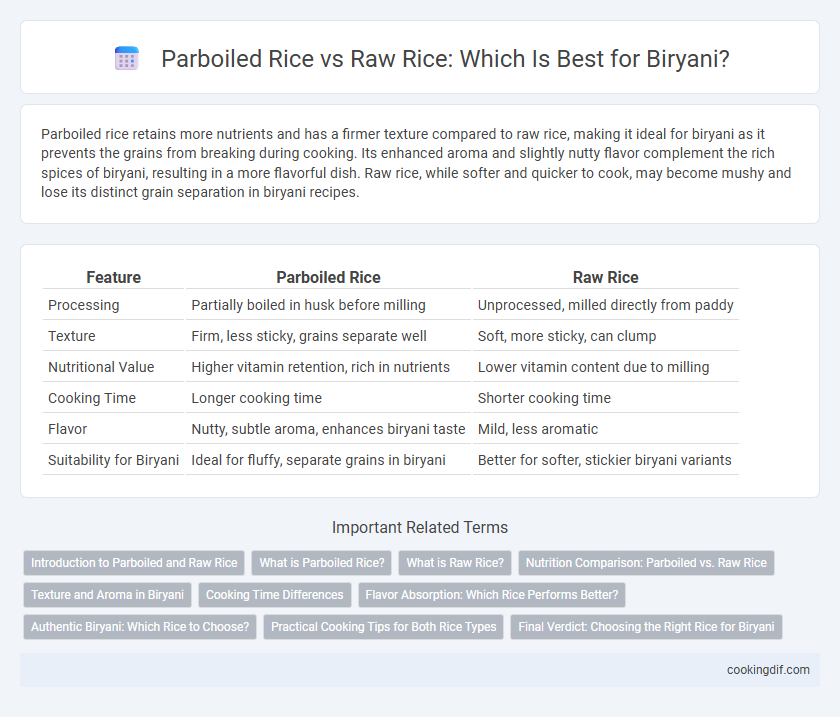Parboiled rice retains more nutrients and has a firmer texture compared to raw rice, making it ideal for biryani as it prevents the grains from breaking during cooking. Its enhanced aroma and slightly nutty flavor complement the rich spices of biryani, resulting in a more flavorful dish. Raw rice, while softer and quicker to cook, may become mushy and lose its distinct grain separation in biryani recipes.
Table of Comparison
| Feature | Parboiled Rice | Raw Rice |
|---|---|---|
| Processing | Partially boiled in husk before milling | Unprocessed, milled directly from paddy |
| Texture | Firm, less sticky, grains separate well | Soft, more sticky, can clump |
| Nutritional Value | Higher vitamin retention, rich in nutrients | Lower vitamin content due to milling |
| Cooking Time | Longer cooking time | Shorter cooking time |
| Flavor | Nutty, subtle aroma, enhances biryani taste | Mild, less aromatic |
| Suitability for Biryani | Ideal for fluffy, separate grains in biryani | Better for softer, stickier biryani variants |
Introduction to Parboiled and Raw Rice
Parboiled rice undergoes partial boiling in the husk, which enhances its nutritional profile by driving nutrients from the bran into the grain and improves its texture by making it firmer and less sticky, ideal for biryani. Raw rice, unprocessed after milling, retains its natural flavor but tends to be softer and stickier, which can affect the distinct layering essential in biryani. Choosing parboiled rice for biryani ensures separate, fluffy grains, while raw rice offers a more delicate, creamy consistency.
What is Parboiled Rice?
Parboiled rice is rice that has been partially boiled in the husk, which improves its nutritional profile and texture by allowing nutrients from the bran to penetrate the grain. This process enhances the rice's firmness and prevents it from becoming mushy, making it ideal for biryani where distinct, separate grains are desired. Compared to raw rice, parboiled rice retains more vitamins like thiamine and has a nuttier flavor that complements the rich spices used in biryani recipes.
What is Raw Rice?
Raw rice, also known as white rice, is rice that has been milled to remove the husk, bran, and germ, resulting in a polished grain with a soft texture and neutral flavor. It absorbs flavors well but tends to become sticky or mushy if overcooked, making it less ideal for biryani's distinct, separate grains. In contrast, parboiled rice undergoes a soaking and steaming process that strengthens the grain, making it firmer and less prone to clumping during cooking.
Nutrition Comparison: Parboiled vs. Raw Rice
Parboiled rice retains more nutrients than raw rice due to the soaking and steaming process that drives vitamins and minerals from the bran into the grain, enhancing its nutritional profile, especially in B vitamins and iron. Raw rice, although less processed, has lower levels of these nutrients because they remain mostly in the removed outer layers. For biryani, parboiled rice offers better nutrition and a firmer texture, making it a preferred choice for both taste and health benefits.
Texture and Aroma in Biryani
Parboiled rice offers a firmer texture and enhanced grain separation ideal for biryani, preventing mushiness during cooking. Raw rice, such as traditional basmati, provides a delicate aroma and softer texture, infusing biryani with its characteristic fragrance. Choosing parboiled rice ensures a robust bite and distinct grains, while raw rice emphasizes the exquisite aroma that defines authentic biryani.
Cooking Time Differences
Parboiled rice significantly reduces cooking time for biryani due to its partially boiled processing, which softens the grains and shortens overall preparation. Raw rice requires longer soaking and cooking periods to achieve the ideal texture for biryani, often leading to extended meal preparation times. Choosing parboiled rice enhances efficiency without compromising the fluffy, separate grain quality essential for biryani.
Flavor Absorption: Which Rice Performs Better?
Parboiled rice has a firmer texture and less starch release compared to raw rice, resulting in better grain separation but slightly reduced flavor absorption in biryani. Raw rice, particularly long-grain varieties like basmati, absorbs spices and aromatic oils more effectively, enhancing the overall taste profile of the dish. For biryani, raw rice offers superior flavor infusion, making it the preferred choice for rich, aromatic preparations.
Authentic Biryani: Which Rice to Choose?
Parboiled rice is preferred for authentic biryani due to its firm texture and ability to absorb spices without becoming mushy, preserving the distinct layers essential to the dish. Raw basmati rice, known for its fragrant aroma and delicate grains, provides a lighter, fluffier texture but may lack the sturdy structure parboiled rice offers during slow cooking. Selecting parboiled rice ensures the biryani maintains its traditional rich flavor and visually appealing grain separation.
Practical Cooking Tips for Both Rice Types
For biryani, parboiled rice retains more nutrients and grains remain separate, making it ideal for long cooking and soaking in spices; rinse thoroughly and soak for 30 minutes before cooking. Raw rice requires careful washing to remove excess starch, soaking for 20-30 minutes, and cautious simmering to prevent mushiness; using a tight lid helps steam the grains evenly. Adjust water ratios according to rice type--1.5 cups for parboiled rice and about 1.25 cups for raw basmati--to achieve fluffy, non-sticky biryani texture.
Final Verdict: Choosing the Right Rice for Biryani
Parboiled rice retains more nutrients and has a firmer texture, making it ideal for biryani that requires distinct, non-sticky grains. Raw rice offers a softer, fluffier consistency, preferred in traditional recipes that emphasize delicate aroma and taste. Selecting the right rice depends on the desired texture and flavor profile, with parboiled rice recommended for durability during cooking and raw rice for authentic softness in biryani.
Parboiled rice vs raw rice for biryani Infographic

 cookingdif.com
cookingdif.com